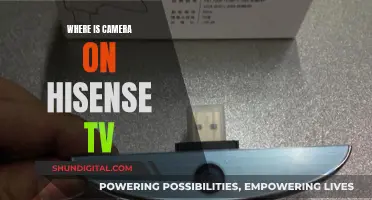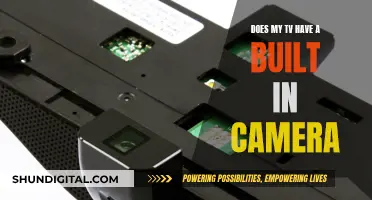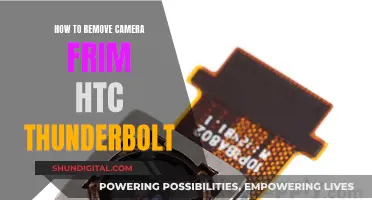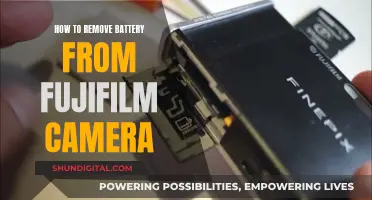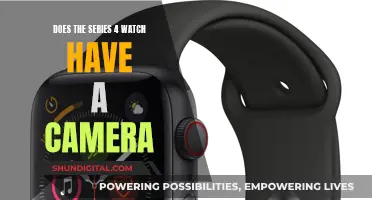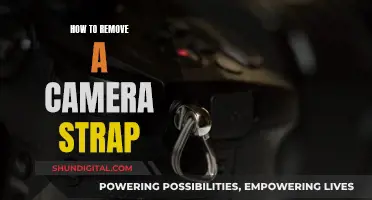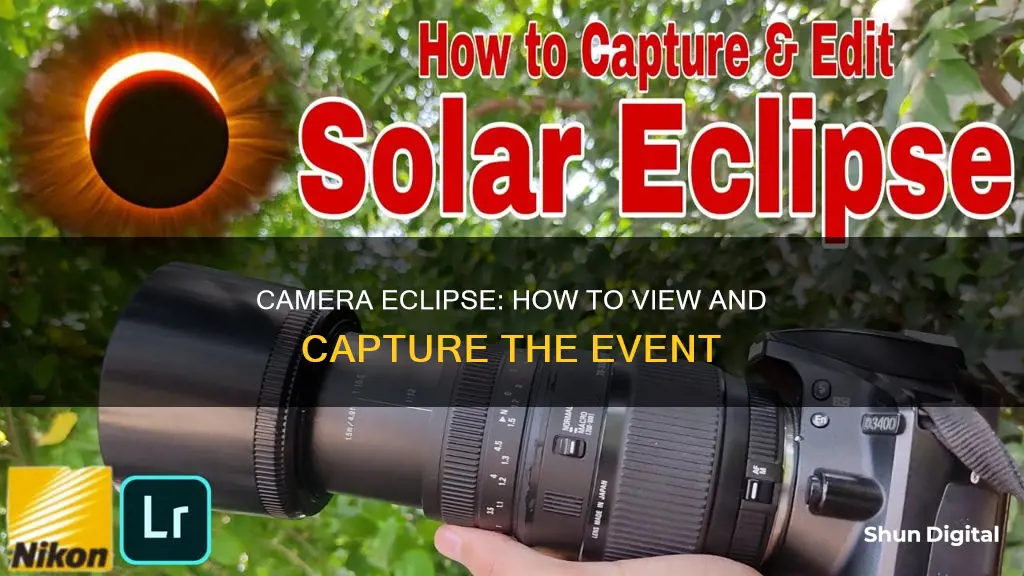
The solar eclipse is a rare phenomenon that occurs when the Earth, moon, and sun align in a perfect and direct line, casting a shadow over the Earth. While it may be tempting to capture this event through your camera, it is important to take the necessary precautions to avoid potential damage to your device. Directly pointing your camera at the sun without proper filters can result in catastrophic damage to the sensitive image sensor. To safely photograph or film the eclipse, it is recommended to use ISO 12312-2 certified eclipse glasses or a sheet of Mylar as a sensor filter. By attaching or taping these filters securely over your camera lens, you can protect your device and capture the eclipse without risk. It is also important to note that you should never look directly at the sun during an eclipse, as it can cause irreversible damage to your retina.
| Characteristics | Values |
|---|---|
| Is it safe to watch an eclipse through your camera? | No, it can damage the camera sensor. |
| Can I use my phone to watch an eclipse? | Yes, but only with a proper filter. |
| What kind of filter should I use? | A special pair of glasses with the right UV filter or a pinhole device. |
| Can I use sunglasses as a filter? | No, only use ISO 12312-2 certified eclipse glasses. |
| Can I watch the eclipse through my phone during the totality phase? | Yes, but only during the few seconds to three minutes when the moon completely blocks the sun. |

Use a solar filter
It is important to protect your eyes and your camera when watching an eclipse. Using a solar filter is a great way to do this.
Firstly, you need to ensure you have the right solar filter. The filter must be made specifically for solar viewing and should be ISO-certified (ISO 12312-2). You can purchase these, and they typically come in the form of a small 4- by 4-inch sheet. It is recommended to buy one that screws in front of the lens, but taping one on will also work.
Secondly, make sure the filter is larger than the camera lens itself. This is important because the sun's strength can damage your eyes and your camera sensor. The filter must be kept on at all times if you are in a location where the eclipse is only partially visible.
If you are using an iPhone, turn off the camera's macro mode when putting a filter in front of the camera. It is also important to note that using a solar filter will not make for a good selfie—the sun will be tiny and the rest of the image will be black.
Finally, if you are in a location where the total eclipse is visible, you can take off the solar filter and capture unfiltered images. During totality, when the moon completely blocks the sun, you can remove the filter to see the sun's outer atmosphere, the corona.
Cameras: Are We Being Watched?
You may want to see also

Use a tripod
Using a tripod is a great way to get stable and professional-looking shots. Here are some tips for using a tripod to watch an eclipse through your camera:
First, decide on your location and set up your tripod accordingly. Point one of the tripod legs in the direction that your camera will face, creating a space for you to stand between the other two legs. This will make it more comfortable for you to work while focusing and shooting. Adjust the height of the tripod legs, extending the thickest sections first as they provide more stable support than the thinner segments. Ensure that the legs are secure and that the tripod is level. Avoid raising the centre post unless it's absolutely necessary, as the three legs provide better stability.
Next, attach your camera to the tripod. Make sure that your camera is compatible with the tripod and secure it tightly to avoid accidents. You may need to use an L-bracket for quick orientation changes. If you're using a heavy lens, mount it on the tripod using its tripod collar instead of letting it hang off the camera mount.
Once your camera is set up on the tripod, you can employ additional techniques to avoid camera shake. Remove the camera strap, as it can cause camera shake in windy situations. Set your camera to its base ISO and turn off Auto ISO to reduce noise and increase dynamic range. Use a remote or cable release to avoid camera shake when taking a photo. Alternatively, you can use the self-timer to create a delay before the shutter releases. If you have a DSLR camera, use the Mirror Up feature to reduce vibration from the mirror movement.
By following these steps, you can effectively use a tripod to watch an eclipse through your camera, ensuring stable and high-quality shots while also protecting your eyes from the harmful effects of looking directly at the sun.
Mobile Cameras and Solar Eclipse: Safe or Not?
You may want to see also

Use 'selfie mode'
If you want to watch an eclipse through your camera, you can use selfie mode. This is a safe way to view an eclipse, as you are not looking directly at the sun. However, it is important to remember that you should not stare at your phone during the eclipse. Even with selfie mode, you can still risk glimpsing the bright sun without a proper filter, which can be dangerous.
When using selfie mode, turn your back to the sun and hold your phone in front of you. This will allow you to see the eclipse on your screen without looking directly at the sun. It is also important to remember that, while selfie mode is a safe way to view the eclipse, it may not provide the best visuals. The sun will be small on your screen and may only be a few pixels across.
If you want to capture the eclipse in photos or videos, using selfie mode can be a good option. You can use a tripod or lean your phone against a stable object to avoid hand jitters and get clearer footage. Additionally, using selfie mode can help you include yourself and your friends in the shot, along with the scenery and the eclipsed sun. This can make for exciting photos that capture the eclipse and the surrounding environment.
It is worth noting that, while selfie mode can be a safe way to view the eclipse, it is crucial to prioritize eye safety. Regular sunglasses are not sufficient for eclipse viewing, and specialized solar viewers or eclipse glasses are recommended. These viewers must comply with ISO 12312-2 standards and meet specific requirements, such as transmitting no more than 0.00032% of sunlight and being free of defects like scratches or bubbles.
Stream Your Arlo Camera Footage Directly to Your TV
You may want to see also

Use time-lapse mode
If you're looking to capture the solar eclipse through your camera, using the time-lapse mode is a great option. Here's a detailed guide on how to do it:
Use a Tripod for Stability:
First, it's essential to have a stable base for your camera. Set up a tripod and mount your camera on it. This will ensure that your camera remains steady during the entire time-lapse sequence. Even a slight shake or movement can ruin your shot, so make sure the tripod is secure and stable.
Prepare Your Camera Settings:
Before starting the time-lapse, take some time to adjust your camera settings. Most cameras will allow you to lock the focus and exposure. Long-press on the display to lock the focus on the sun. Then, adjust the exposure by sliding your finger up or down on the display. Remember to lower the exposure to balance out the brightness of the sun. You can also use pro mode or manual focus to fine-tune these settings further.
Enable Time-Lapse Mode:
Now, it's time to enable time-lapse mode on your camera. If you're using an iPhone or Samsung Galaxy, simply open the camera app and select the time-lapse mode. For other Android devices like the Google Pixel, you may need to install a third-party app like Camera FV-5. These apps will allow you to access time-lapse functionality.
Use a Remote Shutter:
To avoid shaking the camera when starting the time-lapse, use a remote shutter. If you have a smartwatch, such as the Apple Watch, you can use its camera app to trigger the iPhone's camera. Android Wear users can also find apps in the Play Store that function as a remote shutter. Alternatively, you can use a pair of headphones and push the volume buttons while the camera app is open.
Capture the Eclipse:
With your camera and settings ready, it's time to capture the eclipse. Start recording a few minutes before the eclipse begins and continue until a few minutes after it ends. This will give you a complete time-lapse sequence of the event. Remember to keep your camera pointed at the sun throughout the entire process.
Post-Processing:
Once you've captured the time-lapse, you can edit and trim the footage as needed. You can use video editing software or apps like iMovie or GoPro’s QuikStories to trim the beginning and end of the clip, adjust colours, and add any other effects you desire.
Remember, it's crucial to always use proper eye protection when viewing a solar eclipse. Wear eclipse glasses or use a solar filter on your camera to protect your eyes and equipment from direct sunlight.
Big Brother: Is the Government Spying on Us?
You may want to see also

Use a projector
Using a projector is a great way to watch an eclipse safely without needing to look directly at the sun. This method is called pinhole projection, and it's a convenient and safe way to view a solar eclipse.
To make a pinhole projector, you'll need two pieces of stiff white cardboard (paper plates work well) or plain white paper. You can also use a small box, like a cereal box or shoe box, for a more enclosed projector. For the pinhole, you'll need a thumbtack, sharp pin, or needle.
If using cardboard or paper, take one sheet and make a tiny hole in the middle using your pin or thumbtack. Ensure the hole is round and smooth. With your back to the sun, hold one piece of paper or cardboard above your shoulder, allowing the sun to shine on it. The other sheet will act as a screen; hold it at a distance, and you'll see an inverted image of the sun projected onto it through the pinhole. The farther away you hold the screen, the larger the projected image will be.
If using a box, start by eating the cereal or shoes—just kidding! But do keep the box. On a piece of white paper or cardboard, trace the bottom of the box, then cut out the traced rectangle and place it in the bottom of the opened box; this will be your screen. Cut out two squares (around 1.5 inches) on the lid of the box and tape the lid back together. Cover one of the squares with foil and tape it down, then use a pushpin or small nail to make a hole through it—this is your lens. As before, the smaller the hole, the sharper the projected image will be.
Turn away from the sun and let the sun's rays shine through the pinhole. If using a box, look through the other hole in the lid to see the eclipse. If using cardboard or paper, simply hold the second sheet at a distance to see the projection.
Remember, never look directly at the sun without proper eye protection. Sunglasses are not sufficient—only use eclipse glasses or welder's glasses.
Galaxy Watch 3: Camera Expectations and Realities
You may want to see also
Frequently asked questions
No, it is not safe to look at a solar eclipse through your camera. The sun can damage the image sensor in your camera, and in some cases, may even melt the inside of your camera.
If you want to watch the eclipse through your camera, you will need to use a protective filter. You can use ISO 12312-2 certified eclipse glasses or a sheet of Mylar to cover your camera lens.
Yes, you can use your phone to watch the eclipse, but only during the totality phase when the moon completely blocks the sun. You will still need to use a protective filter for your phone.
To photograph the eclipse, use a solar filter in front of your camera lens. You can purchase one that screws in front of the lens or tape one on. Make sure the filter is larger than the lens and keep it on at all times during the viewing. Using a tripod will help you avoid blurry images.
No, even if you are not looking at the screen of your camera, you can still damage the image sensor without a protective filter.


